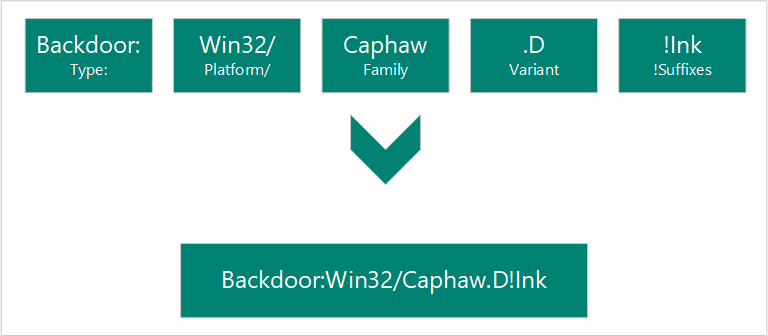Malwarenamen
We noemen de malware en ongewenste software die we detecteren volgens het naamgevingsschema van de Computer Antivirus Research Organization (CARO). Het schema gebruikt de volgende indeling:

Wanneer onze analisten een bepaalde bedreiging onderzoeken, bepalen ze wat de naam van elk onderdeel is.
Beschrijft wat de malware op uw computer doet. Wormen, virussen, Trojans, backdoors en ransomware zijn enkele van de meest voorkomende soorten malware.
* Adware
* Backdoor
* Behavior
* BrowserModifier
* Constructor
* DDoS
* Exploit
* HackTool
* Joke
* Misleading
* MonitoringTool
* Program
* Personal Web Server (PWS)
* Ransom
* RemoteAccess
* Rogue
* SettingsModifier
* SoftwareBundler
* Spammer
* Spoofer
* Spyware
* Tool
* Trojan
* TrojanClicker
* TrojanDownloader
* TrojanNotifier
* TrojanProxy
* TrojanSpy
* VirTool
* Virus
* Worm
Platforms begeleiden de malware naar het compatibele besturingssysteem (zoals Windows, macOS en Android). De richtlijnen van het platform worden ook gebruikt voor programmeertalen en bestandsindelingen.
* AndroidOS: Android operating system
* DOS: MS-DOS platform
* EPOC: Psion devices
* FreeBSD: FreeBSD platform
* iOS: iPhone operating system
* Linux: Linux platform
* macOS: MAC 9.x platform or earlier
* macOS_X: macOS X or later
* OS2: OS2 platform
* Palm: Palm operating system
* Solaris: System V-based Unix platforms
* SunOS: Unix platforms 4.1.3 or lower
* SymbOS: Symbian operating system
* Unix: general Unix platforms
* Win16: Win16 (3.1) platform
* Win2K: Windows 2000 platform
* Win32: Windows 32-bit platform
* Win64: Windows 64-bit platform
* Win95: Windows 95, 98 and ME platforms
* Win98: Windows 98 platform only
* WinCE: Windows CE platform
* WinNT: WinNT
* ABAP: Advanced Business Application Programming scripts
* ALisp: ALisp scripts
* AmiPro: AmiPro script
* ANSI: American National Standards Institute scripts
* AppleScript: compiled Apple scripts
* ASP: Active Server Pages scripts
* AutoIt: AutoIT scripts
* BAS: Basic scripts
* BAT: Basic scripts
* CorelScript: Corelscript scripts
* HTA: HTML Application scripts
* HTML: HTML Application scripts
* INF: Install scripts
* IRC: mIRC/pIRC scripts
* Java: Java binaries (classes)
* JS: JavaScript scripts
* LOGO: LOGO scripts
* MPB: MapBasic scripts
* MSH: Monad shell scripts
* MSIL: .NET intermediate language scripts
* Perl: Perl scripts
* PHP: Hypertext Preprocessor scripts
* Python: Python scripts
* SAP: SAP platform scripts
* SH: Shell scripts
* VBA: Visual Basic for Applications scripts
* VBS: Visual Basic scripts
* WinBAT: Winbatch scripts
* WinHlp: Windows Help scripts
* WinREG: Windows registry scripts
* A97M: Access 97, 2000, XP, 2003, 2007, and 2010 macros
* HE: macro scripting
* O97M: Office 97, 2000, XP, 2003, 2007, and 2010 macros - those that affect Word, Excel, and PowerPoint
* PP97M: PowerPoint 97, 2000, XP, 2003, 2007, and 2010 macros
* V5M: Visio5 macros
* W1M: Word1Macro
* W2M: Word2Macro
* W97M: Word 97, 2000, XP, 2003, 2007, and 2010 macros
* WM: Word 95 macros
* X97M: Excel 97, 2000, XP, 2003, 2007, and 2010 macros
* XF: Excel formulas
* XM: Excel 95 macros
* ASX: XML metafile of Windows Media .asf files
* HC: HyperCard Apple scripts
* MIME: MIME packets
* Netware: Novell Netware files
* QT: Quicktime files
* SB: StarBasic (StarOffice XML) files
* SWF: Shockwave Flash files
* TSQL: MS SQL server files
* XML: XML files
Groepering van malware op basis van gemeenschappelijke kenmerken, waaronder toeschrijving aan dezelfde auteurs. Providers van beveiligingssoftware gebruiken soms verschillende namen voor dezelfde malwarefamilie.
Sequentieel gebruikt voor elke afzonderlijke versie van een malware-familie. De detectie voor de variant .AF zou bijvoorbeeld zijn gemaakt na de detectie voor de variant '. AE".
Biedt extra informatie over de malware, waaronder hoe deze wordt gebruikt als onderdeel van een bedreiging met meerdere onderdelen. In het voorgaande voorbeeld geeft '!lnk' aan dat het bedreigingsonderdeel een snelkoppelingsbestand is dat wordt gebruikt door Trojan: Win32/Reveton.T.
* .dam: damaged malware
* .dll: Dynamic Link Library component of a malware
* .dr: dropper component of a malware
* .gen: malware that is detected using a generic signature
* .kit: virus constructor
* .ldr: loader component of a malware
* .pak: compressed malware
* .plugin: plug-in component
* .remnants: remnants of a virus
* .worm: worm component of that malware
* !bit: an internal category used to refer to some threats
* !cl: an internal category used to refer to some threats
* !dha: an internal category used to refer to some threats
* !pfn: an internal category used to refer to some threats
* !plock: an internal category used to refer to some threats
* !rfn: an internal category used to refer to some threats
* !rootkit: rootkit component of that malware
* @m: worm mailers
* @mm: mass mailer worm